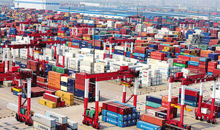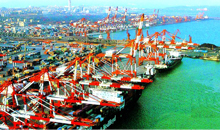China's trade surplus is here to stay
Source:forbes.com
China’s growth story in the past twenty or more years has been all about trade. Its trade surplus, or the value of exports minus imports, has been a topic of heated discussion among US politicians who argued that China’s exports were so attractive to Americans in particular because they were intentionally underpriced, undercutting American producers.

China’s trade surplus is here to stay.
China’s growth story in the past twenty or more years has been all about trade. Its trade surplus, or the value of exports minus imports, has been a topic of heated discussion among US politicians who argued that China’s exports were so attractive to Americans in particular because they were intentionally underpriced, undercutting American producers. Now, even as China supposedly moves away from a trade-based economy, the nation continues to hold a trade surplus and to continuously expand its trade regime in some important directions.
The trade data shows that trade as a whole shrank in 2015 due to the economic slowdown, falling commodity prices, and currency devaluation. Exports declined by 2.8% while imports fell by 14.1%. This means that the trade surplus remained, even grew, in 2015, despite the overall decline in the volume of trade. Something else to point out is that the trade data says that China is not moving too quickly out of its role as “factory of the world,” since it continues to produce both high-tech and low-tech goods. Case in point, exports of electrical machinery, aircraft, furniture, and toys rose in 2015, continuing a general rising trend over a ten-year period. Export declines were brought about in part by declining commodity prices, leading to lower exports of nickel, copper, and iron ore in 2015 than in 2014. A similar trend has continued into the early months of 2016, as trade has remained relatively weak. This suggests that as commodity prices rise again, Chinese export growth will expand.
What this means is that a) the trade surplus is continuing to hold — China’s domestic economy is not growing fast enough for domestic consumption of imports to rise by more than the foreign consumption of Chinese goods, and b) China’s manufacturing regime is going strong (more or less), revealing that the nation continues to generate a large percentage of the goods that the world consumes. This is occurring despite the fact that wages have risen and some multinationals, such as Tiffany and Mineaba, have moved to lower-wage nations, particularly in Southeast Asia. Particularly if trade trends for 2015 and early 2016 are just a blip on the overall expanding trade agenda, China will remain a manufacturing giant. Also, the economy has not, in fact, restructured sufficiently toward a consumption-based economy, even though domestic consumption is slowly rising.
Politicians like Donald Trump have trotted out the Chinese trade surplus with the US as evidence that China is “cheating” its trade partners and manipulating its currency. Yet this same surplus has made China the largest foreign holder of US Treasury bonds, which finance US government spending. Also, Chinese exports to the US are often manufactured by American multinationals that have moved abroad to increase profit margins. So pointing the finger at China for “cheating” trade partners doesn’t pan out, but that hasn’t made it less attractive to politicians seeking a scapegoat for mounting American debt. Despite the woeful shortcomings of Trump’s argument, this issue will likely remain a flash point for anti-Chinese sentiment in the short to medium run as China’s surplus remains large.
Something else to point out—in recent months, China has needed a trade surplus to generate foreign exchange reserves. This is because it is experiencing rapid capital outflows which deplete these reserves (although possibly less so in June). This occurred due to the US Federal Reserve’s rate hike in December of 2015 which increased returns on the dollar, depreciation of the RMB, and has been ongoing due to weaknesses in China’s economy. Foreign exchange reserves have also declined since the People’s Bank of China has sought to defend the Renminbi exchange rate, reducing speculation pressures against the currency.
At least in the near future, the value of the RMB will remain critically important, as will the strength of China’s manufacturing sector. China’s export regime may be a saving grace in an economy that is struggling to change.
(Source: forbes.com Author: Sara Hsu)





 沪公网安备31010402003309号
沪公网安备31010402003309号



